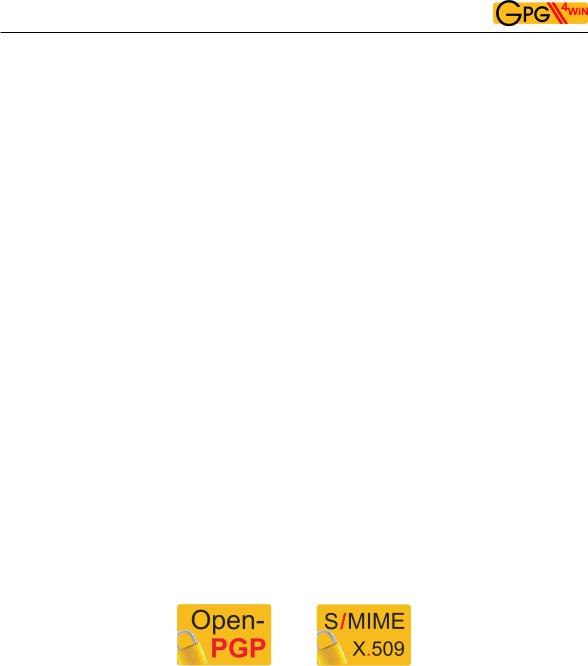
- •Contents
- •3 How Gpg4win works
- •4 The passphrase
- •5 Two methods, one goal: OpenPGP & S/MIME
- •6 Installing Gpg4win
- •8.1 Publishing per e-mail, with practice for OpenPGP
- •12 Encrypting e-mails
- •13 Signing e-mails
- •13.1 Signing with GpgOL
- •13.2 Checking signatures with GpgOL
- •13.3 Reasons for a broken signature
- •13.4 Encryption and signature
- •14 Archiving e-mails in an encrypted form
- •19.1 Export
- •19.2 Import
- •21 Known problems and help
- •21.1 GpgOL menus and dialogs no longer found in Outlook
- •21.2 GpgOL buttons are not on the Outlook 2003 toolbar
- •21.4 Errors when starting GpgOL
- •21.5 Installation of Gpg4win on a virtual drive
- •21.8 S/MIME operations not allowed (CRLs not available)
- •22 Files and settings in Gpg4win
- •22.1 Personal user settings
- •24 Why Gpg4win cannot be broken ...
- •25 GnuPG and the mystery of large numbers
- •25.1 Calcualting with residue classes
- •25.2 RSA algorithm and calculating with residue classes
- •25.3 RSA encryption with small numbers
- •25.4 Display using different base numbers
- •B Using GnuPG with other e-mail programs
- •C Automatic installation of Gpg4win
- •D Transfer from other programs
- •E Uninstalling Gpg4win
- •G GNU Free Documentation License
- •Index

4 The passphrase
As we have seen in the last chapter, the private key is one of the most important components of the “public key” or asymmetric encryption method. While one no longer needs to exchange the key with another party in secret, the security of this key is nevertheless the "key" to the security of the “entire” encryption process.
On a technical level, a private key is nothing more than a file which is stored on your computer. To prevent unauthorised access of this file, it is secured in two ways:
First, no other user may read or write in the file – which is difficult to warrant, since computer administrators always have access to all files, and the computer may be lost or attacked by viruses, worms or Trojans .
For this reason we need another layer of protection: the passphrase. This is not a password – a passphrase should not consist of only one word, but a sentence, for example. You really should keep this passphrase “in your head” and never have to write it down.
At the same time, it cannot be possible to guess it. This may sound contradictory, but it is not. There are several proven methods of finding very unique and easy to remember passphrases, which cannot be easily guessed.
25

The Gpg4win Compendium 3.0.0-beta1
Chapter 4. The passphrase
Think of a phrase that is very familiar to you, e.g.:
People in glass houses should not be throwing stones.
Now, take every third letter of this sentence:
oegsoehloerisn (People in glass houses should not be throwing stones.)
While it may not be easy to remember this sequence of letters, it is also unlikely that you will forget how to arrive at the passphrase it as long as you remember the original sentence. Over time, and the more often you use the phrase, you will commit it to memory. No one else can guess the passphrase.
Think of an event that you know you will never forget about. Maybe it’s a phrase that you will always associate with your child or partner, i.e. it has become “unforgettable”. Or a holiday memory or a line of text of a song that is personally important to you.
Use capital and small letters, numbers, special characters and spaces, in any order. In principle, anything goes, including umlaute, special characters, digits etc. But remember – if you want to use your secret key abroad at a different computer, please remember that not all keyboards may have such special characters. For example, you will likely only find umlaute (ä, ö, ü usw.) on German keyboards.
You can also make intentional grammar mistakes, e.g. “mustake” instead of “mistake”. Of course you also have to be able to remember these “mustakes”. Or, change languages in the middle of the phrase. You can change the sentence:
In München steht ein Hofbräuhaus.
into this passphrase:
inMinschen stet 1h0f breuhome
Think of a sentence that does not make sense, but you can still remember e.g.:
The expert lamenting nuclear homes
Knitting an accordeon, even during storms.
A passphrase of this length provides good protection for your secret key.
It can also be shorter if you use capital letters, for example:
THe ExPERt laMenTIng NuclEAr hoMES.
While the passphrase is now shorter, it is also more difficult to remember. If you make your passphrase even shorter by using special characters, you will save some time entering the passphrase, but it is also morr likely that you will forget your passphrase.
Here is an extreme example of a very short but also very secure passphrase:
R!Qw"s,UIb *7\$
However, in practice, such sequences of characters have not proven themselves to be very useful, since there are simply too few clues by which to remember them.
26

The Gpg4win Compendium 3.0.0-beta1
Chapter 4. The passphrase
A bad passphrase can be “broken” very quickly, if it ...
... is already used for another purpose (e.g. for an e-mail account or your mobile phone). The same passphrase would therefore already be known to another, possibly not secure, software. If the hacker is successful, your passphrase becomes virtually worthless.
... comes from a dictionary. Passphrase finder programs can run a password through complete digital dictionaries in a matter of minutes – until it matches one of the words.
... consists of a birth date, a name or other public information. Anyone planning to decrypt your e-mail will obtain this type of information.
... is a very common quote, such as “to be or not to be”. Passphrase finder programs also use quotes like these to break passphrases.
... consists of only one word or less than 8 characters. It is very important that you think of a longer passphrase.
When composing your passphrase, please do not use any of the aforementioned examples. Because anyone seriously interested in getting his hands on your passphrase will naturally see if you used one of these examples.
Be creative! Think of a passphrase now! Unforgettable and unbreakable.
In Chapter 7 you will need this passphrase to create your key pair.
But until then, you have to address another problem: Someone has to verify that the person that wants to send you a secret message is real.
27
5Two methods, one goal: OpenPGP & S/MIME
You have seen the importance of the “envelope” for your e-mail and how to provide one using tools of modern information technology: a mail strongbox, in which anyone can deposit encrypted mails which only you, the owner of the strongbox, can decrypt. It is not possible to break the encryption as long as the private key to your “strongbox” remains your secret.
Still: If you think about it, there is still another problem. A little further up you read about how – in contrast to the secret key method – you do not need to personally meet the person you are corresponding with in order to enable them to send a secret message. But how can you be sure that this person is actually who they say they are? In the case of e-mails, you only rarely know all of the people you are corresponding with on a personal level – and it is not usually easy to find out who is really behind an e-mail address. Hence, we not only need to warrant the secrecy of the message, but also the identity of the sender – specifically authenticity.
Hence someone must authenticate that the person who wants to send you a secret message is real. In everyday life, we use ID, signatures or certificates authenticated by authorities or notaries for “authentication” purposes. These institutions derive their right to issue notarisations from a higherranking authority and finally from legislators. Seen another way, it describes a chain of trust which runs from “the top” to “the bottom”, and is described as a “hierarchical trust concept”.
In the case of Gpg4win or other e-mail encryption programs, this concept is found in almost mirror-like fashion in S/MIME. Added to this isOpenPGP, another concept that only works this way on the Internet. S/MIME und OpenPGP have the same task: the encryption and signing of data. Both use the already familiar public key method. While there are some important differences, in the end, none of these standards offer any general advantage over another. For this reason you can use Gpg4win to use both methods.
28

The Gpg4win Compendium 3.0.0-beta1
Chapter 5. Two methods, one goal: OpenPGP & S/MIME
The equivalent of the hierarchical trust concept is called “Secure / Multipurpose Internet Mail Extension” or S/MIME. If you use S/MIME, your key must be authenticated by an accredited organisation before it can be used. The certificate of this organisation in turn was authenticated by a higher-ranking organisation etc. – until we arrive at a so-called root certificate. This hierarchical chain of trust usually has three links: the root certificate, the certificate of the issuer of the certificate (also CA for Certificate Authority), and finally your own user certificate.
A second alternative and non-compatible notarisation method is the OpenPGP standard, does not build a trust hierarchy but rather assembles a “Web of trust”. The Web of Trust represents the basic structure of the non-hierarchical Internet and its users. For example, if User B trusts User A, then User B could also trust the public key of User C, whom he does not know, if this key has been authenticated by User A.
Therefore OpenPGP offers the option of exchanging encrypted data and e-mails without authentication by a higher-ranking agency. It is sufficient if you trust the e-mail address and associated certificate of the person you are communicating with.
Whether with a trust hierarchy or Web of Trust – the authentication of the sender is at least as important as protecting the message. We will return to this important protection feature later in the compendium. For now, this information should be sufficient to install Gpg4win and understand the following chapters:
Both methods – OpenPGP andS/MIME – offer the required security.
The methods are not compatible with each other. They offer two alternate methods for authenticating your secret communication. Therefore they are not deemed to be interoperable.
Gpg4win allows for the convenient and parallel use of both methods – you do not have to choose one or the other for encryption/signing purposes.
Chapter 7 of this compendium, which discusses the creation of the key pair, therefore branches off to discuss both methods. At the end of Chapter 7 the information is combined again.
In this compendium, these two symbols will be used to refer to the two alternative methods:
29
